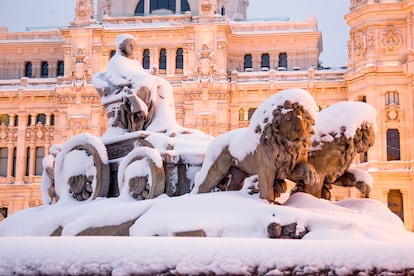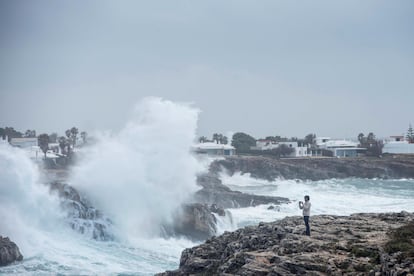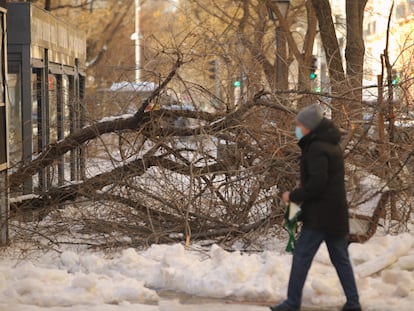Is this winter’s crazy weather in Spain a taste of things to come?
The country is emerging from three months of extremes in line with climate change scenarios, including the snowfall of the century, back-to-back storms and wild temperature swings


From the biggest snowfall in a century and an exceptional cold snap, to unseasonable highs, this winter has gone from one extreme to another in Spain, swinging within a temperature range of 50ºC and keeping everyone in a constant state of surprise.
During this past season, which for meteorological purposes started on December 1 and ended on February 28 (as opposed to the astronomical winter, from December 21 to March 20), Spain experienced the entire spectrum of possibilities, “many extreme, some very adverse and several completely unusual,” says Rubén del Campo, the spokesman for the AEMET national weather agency.
Del Campo explains that a storm in late December holds the key to the chain of atypical meteorological episodes that followed. Its intense northerly winds brought an arctic air mass to the peninsula, which became stagnant and continued to cool. The interaction between this mass and Storm Filomena’s air flow, which was very humid and relatively warm, caused a massive snowfall, the scale of which had not been seen in Madrid since 1904.

A second cold snap followed in the wake of Filomena, breaking five records for the lowest minimum temperature. But it wasn’t only the minimum temperatures that were below freezing: the thermometer barely rose during daylight hours either, so two records for the lowest maximum temperatures were also broken. Within scarcely 10 days, the pendulum had swung in the opposite direction, with unusually high temperatures that broke 20 records. On January 29, readings on thermometers reached almost 30ºC in Alicante, the highest temperature ever recorded in January by AEMET. Between the -25.2ºC felt that day in Molina, in Castilla-La Mancha, and the 29.8ºC reading in Alicante, there was a difference of 55ºC, an unprecedented temperature range in Spain.
Meanwhile, Storm Hortense triggered a bizarre meteorological episode on January 22. “There might normally be a storm in January every 10 or 15 years in the central zone of Spain,” says Del Campo, who contrasts this fact with this winter’s series of squalls, which he qualifies as “an unusual touch in an already unusual situation.” Even more staggering is the fact that the phenomenon was repeated on February 5. “If it is already unusual to have one [storm of this nature] in winter, two is really exceptional,” he says. And, to cap it all, there were two very intense episodes of suspended dust in February, which he describes as “quite unusual.” The first one caused a muddy downpour that reached as far as the Pyrenees, where it turned the snow a deep shade of ochre in a weather event not seen for 30 years.
So has the weather gone crazy this winter? “It has been a season of extremes and almost nothing that happened was usual,” says Del Campo. “I don’t know if the weather has gone mad, but it’s certainly more so than in other winters.”
Energized atmosphere

The veteran meteorologist Ángel Rivera prefers to describe the weather as “energized.” In his opinion, what happened is “the expression of an atmosphere with more energy” caused by the arrival of “relatively warm and very humid air from tropical areas.” Researching the reasons for this should be given top priority, he adds, “as it is a pattern that is becoming increasingly frequent and has consequences for Spain.”
But where does the extra energy come from? “From the oceans, the great repository where 90% of the heat retained by greenhouse gases accumulates,” says Rivera. “It is the oceans, especially in tropical and subtropical areas, that release this into the atmosphere, heating the air and producing the water that evaporates and collects as vapor, which generates even more energy as it rises and condenses.”
José Miguel Viñas, of the weather service Meteored, points out that although the “crazy winter weather is not extraordinary,” it has departed from what we would consider normal. Viñas attributes this to “a jet stream – a kind of aerial highway that circulates from west to east with intense winds, separating the cold air masses of the north from the warm ones of the south – with greater fluctuations.” These fluctuations interact with warmer air masses from more southerly latitudes, giving rise to “storm trains” that generate a succession of adverse weather conditions.
The increased frequency of heatwaves does not mean that cold snaps will disappear. And the cold is just as big a risk to human health
Is there something linking these weather events? “In recent years, a large number of adverse phenomena have been occurring in Spain, with twice as many heatwaves as in the previous decade, and increasingly intense torrential rains,” says Del Campo. “All this fits in with the climate change scenarios in which the average temperature rises and the variance increases, i.e., the climate becomes more extreme, with more frequent and longer periods of drought and rain.” Like Rivera, Del Campo reminds us, however, that it is necessary to analyze each phenomenon to confirm the connection.
The increased frequency of heatwaves does not mean that cold snaps will disappear. And the cold is just as big a risk to human health. The researcher Julio Díaz Jiménez, from the Carlos III Health Institute, points out that an average of 1,300 people died each year between 2001 and 2010 in Spain when their various health conditions were aggravated by heat, while 1,100 died from the cold during the same period, with a higher daily average – “and there are no national prevention plans or specific health alerts for cold, as there are for heat,” he adds.
In his opinion, cold snaps are viewed as being of less concern because the effects are diluted, with deaths occurring seven to 14 days after temperatures plummet. “The more we adapt to the heat, the more we become unadapted to the cold,” he warns. In fact, the death rate for each degree increase rose by 14% between 1983 and 2003 but now rises by barely 2%, while for each degree drop it remains at a constant 5%. The biologist Francisco Heras, from the Climate Change Information Office at the Environment Ministry, stresses that the health authorities are working on a plan to help deal with the impact from the cold, and are also considering plans for other adverse weather conditions such as floods and storms. “The risks may become increasingly important, but the impact can be limited and reduced,” he says.
But what are the repercussions on the environment? Manuel Morales Prieto, who teaches ecology at Madrid’s Autonomous University, explains that the frost has proved more harmful to plants than the snowfall as the cold damages the plants’ tissue. As far as wildlife is concerned, he states that any species in equilibrium is quite resilient to isolated extreme episodes, which can even be beneficial in evolutionary terms. However, natural equilibrium barely exists anymore as most habitats have been modified by humans, so it is reasonable to assume that this has caused “an enormous direct impact on mortality and a sharp drop in reproduction,” according to Morales.
When it comes to birds, Morales fears serious consequences for those that winter here and for non-migratory species. The effect is “really disastrous in small populations, as it can trigger their decline,” he says. If, as predicted, extreme weather is repeated frequently, “there will be a devastating cumulative effect on endangered species and entire populations may be wiped out on a large scale.”
English version by Heather Galloway.
Tu suscripción se está usando en otro dispositivo
¿Quieres añadir otro usuario a tu suscripción?
Si continúas leyendo en este dispositivo, no se podrá leer en el otro.
FlechaTu suscripción se está usando en otro dispositivo y solo puedes acceder a EL PAÍS desde un dispositivo a la vez.
Si quieres compartir tu cuenta, cambia tu suscripción a la modalidad Premium, así podrás añadir otro usuario. Cada uno accederá con su propia cuenta de email, lo que os permitirá personalizar vuestra experiencia en EL PAÍS.
¿Tienes una suscripción de empresa? Accede aquí para contratar más cuentas.
En el caso de no saber quién está usando tu cuenta, te recomendamos cambiar tu contraseña aquí.
Si decides continuar compartiendo tu cuenta, este mensaje se mostrará en tu dispositivo y en el de la otra persona que está usando tu cuenta de forma indefinida, afectando a tu experiencia de lectura. Puedes consultar aquí los términos y condiciones de la suscripción digital.
More information
Últimas noticias
Most viewed
- Sinaloa Cartel war is taking its toll on Los Chapitos
- Oona Chaplin: ‘I told James Cameron that I was living in a treehouse and starting a permaculture project with a friend’
- Reinhard Genzel, Nobel laureate in physics: ‘One-minute videos will never give you the truth’
- Why the price of coffee has skyrocketed: from Brazilian plantations to specialty coffee houses
- Silver prices are going crazy: This is what’s fueling the rally










































